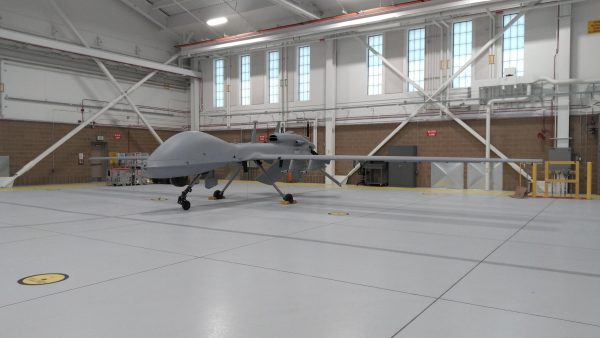
Fort Wainwright has completed construction of a $40 million hangar that will serve as the new home for unmanned, remotely piloted aircraft. The new hangar will house up to a dozen Gray Eagle drones.
The Gray Eagle has been flying around Fort Wainwright for about three years now, operating out of the old Hangar 1 on post. That’s the structure built in 1942 that was used among other things for ferrying aircraft to Russia during World War II as part of the old Lend-Lease Program. But now, the drones have a home of their own.
“Now we’re taking over the new hangar, Hangar 3, which was purpose-built for us and the unit,” said Capt. Chad Howard a company commander with the Wainwright-based unit that operates the Gray Eagles.
“This really signifies being fully established in Alaska,” he said in an interview Wednesday.
Howard says the nearly 57,000-square-foot hangar will accommodate up to a dozen of the Gray Eagles, which he calls a 21st century warfighting platform. They’re operated by the 1st Attack Reconnaissance Battalion of the 25th Aviation Regiment. Chief Warrant Officer 3 Christopher Herrmann is the operations officer for the 1st of the 25th’s Delta Company.
Herrmman says the unmanned aircraft system’s sensors can scan the battlefield and monitor enemy communications then relay that data to commanders on the ground.
“We’re able to provide that information to that ground commander or that ground troop wherever he is on the battlefield, directly to him, so he can see around that corner, to see an enemy,” he said.
Howard says the Gray Eagles also carry four Hellfire missiles to offer battlefield commanders some tactical assistance from on high. He says the soldiers flying the Gray Eagles train to operate with the 1st of the 25th’s Apache attack helicopters, also based at Wainwright. He says the combination of the two types of aircraft create a powerful force on the battlefield.
“We would be able to utilize both the Gray Eagle and the Apache to enhance the capabilities together,” he said.
Howard says the Gray Eagle operators use airspace over the big training ranges around the interior. They’re also now using the airfield at Fort Greely – as they did during a 2018 cold-weather exercise called Arctic Anvil.
“Last year, we conducted our first operation down at Fort Greely,” he said. “We went down there and did Arctic flights from Allen Army Airfield in support of Arctic Anvil.”
Howard says area residents may occasionally notice the oddly shaped, push-propeller-powered aircraft as they take off and land at the Army airfields. They’ve already been noticed by officials with local civilian remotely piloted aircraft operator: that’s Cathy Cahill, director of the Alaska Center for Unmanned Aircraft Systems Integration at the University of Alaska Fairbanks.
“They are a showcase of unmanned aircraft capability in the Arctic,” Cahill said Wednesday, “and it’s nice that they’re finally getting housing worthy of these amazing aircraft.
Cahill says the Center conducted its first Defense-related project last summer, when it surveyed Alaska’s northern coast for the U.S. Naval Research Laboratory. She says the Center would like to explore other DoD-related opportunities. Howard says there’s already been some discussions about that and he says officials with the 1st of the 25th are open to the idea.
Tim Ellis is a reporter at KUAC in Fairbanks.




